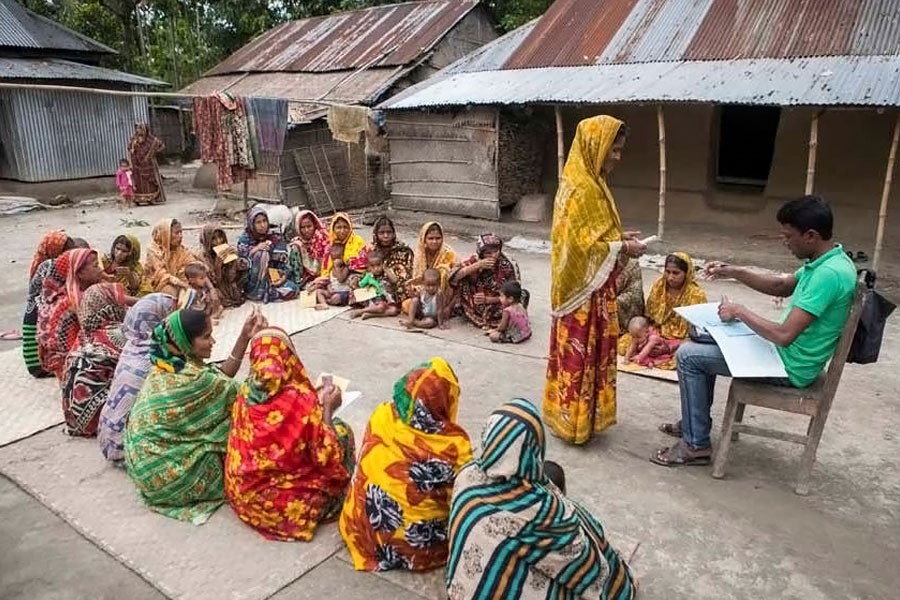When Bangladesh's microfinance sector came into being in the 1970s, its main goal was reducing rural poverty by providing microcredit loans for non-crop activities such as trading, and raising livestock and poultry. No doubt, direct or indirect impact of microfinancing helped the country to reduce poverty considerably. Extreme poverty in the country was visibly reduced by nearly 8.0 per cent by 2016.
In Bangladesh there are mainly four types of institutions involved in microfinance activities. These are Grameen Bank (GB), around 1500 non-government organisations (NGO), commercial and specialised banks like Bangladesh Krishi Bank (BKB), Rajshahi Krishi Unnayan Bank (RAKUB), and government-sponsored microfinance projects.
All the programmes are targeted at the landless rural poor. The microfinance institutions (MFIs) provide mostly small, un-collateralised one-year term loans to individuals belonging to jointly liable peer groups. They use similar on-site loan disbursement and weekly collection methods by forming village organisations.
The NGOs started credit programme in the mid-1980s and their activities increased noticeably after 1990. With the increasing number of collateral-free micro credit disbursement by the MFIs, some nationalised commercial banks (NCBs), and specialised banks were encouraged to provide a considerable amount of their rural credit to the poor without security. Today, some of the private commercial banks (PCBs) have also started direct and linkage programmes with the NGOs.
However, transformation of the MFIs was inevitable considering rural economic growth and financial inclusion requirements of Bangladesh where some 50 per cent of the adult population remain unbanked.
The MFIs have indeed positively impacted financial inclusion, savings and lendings, especially in remote areas. A study on the microfinance operations in the country says microfinance institutions should deepen financial inclusion by addressing the financial needs of the unbanked people and small businesses.
It also says the MFIs could continue widening access to finance if new rules and acts were enacted and existing ones amended. It shows that large microfinance institutions might create pathways for a gradual transformation to specialised banks, resulting in an improved customer base and growth.
Bangladesh Bank and the Microcredit Regulatory Authority are implementing a 6.5-year project, funded by DfID, Bangladesh, with Financial Institutions Division at the Ministry of Finance as the executing agency.
The project aims to improve access to finance for micro and small enterprises and create economic opportunities for small business. This would be brought about by improvements in policy and regulation of financial services, innovations in the nature and scope of financial services targeting the poor and strengthening of information systems.
Bangladesh is acclaimed globally for its success in microcredit operations. The world is appreciative of the country for its microcredit success as the poor have benefited through their access to credit from non-banking financial institutions.
Microcredit has, in fact, revolutionised the country's socio-economic sector. It has empowered the impoverished people to come forward and participate in economic activities. It has brought Bangladesh Nobel Peace Prize for being a microcredit model. However, there are some gray areas too.
While the NGOs involved in microcredit programmes flourished, the borrowers were perhaps not benefited in that proportion. The lending institutions started taking 30-40 per cent interest on loans. There were no fixed rules either.
'Microcredit Regularity Authority' (MRA) was formed in 2006 to ensure transparency in activities of the micro-lending institutions. The high interest rates of microcredit were widely criticised at home and abroad.
Then the government fixed the interest ceiling at 27 per cent in 2010. It was said that gradually the rates would be reduced further, but nothing has been done about this over the last one decade.
The government has recently decided to slash down interest rates on microcredit provided by the NGOs by 3.0 per cent in order to attain the Sustainable Development Goals (SDGs). The finance ministry approved the interest rates at 24 per cent after the authorities introduced the recommendation.
The Palli Karma-Sahayak Foundation (PKSF) is the main source of funding for microcredit operations. The NGOs receive loans from PKSF on only 4-6 per cent interest rate. So the rate of interest for microcredit should not exceed 20 per cent. There was an argument that the micro-creditors go to the clients that involves cost, while clients go to banks in conventional banking system.
The rate reduction of interest for microcredit is commendable. The apprehensions expressed by several quarters that the decision would affect the lending organisations are baseless. No organisation has ever turned bankrupt because of interest rates.
Rather, the wealth of the lending organisations increased gradually. In fact, sustainable poverty alleviation requires elimination of causes of structural poverty, along with access to property, socio-economic institutions dealing with education, market, health, sanitation and finance.
As of now, the country's poverty reduction programmes have made a good progress as a total of 350 million out of 400 million poor people are getting microcredit facilities over the last couple of years.
It is also true that by riding on contributions of the MFIs, Bangladesh did achieve the Millennium Development Goal (MDG) on poverty much ahead of the UN-set deadline.
Everywhere, the poor are using loans as small as $25 or $30 to create income: raising chickens to sell eggs, opening small retail businesses, or buying sewing machines. Moreover, loans are being repaid on time.
Disadvantaged people in Bangladesh, like elsewhere, are easily trapped in a cycle of poverty. Those without land and with little or no education or income face tougher obstacles to adequate employment and economic downturns.
Against this backdrop, there is a vital need to continue this microcredit programme throughout the country. Millions of people are in dire need of subsistence only. They need microcredit for their survival.


